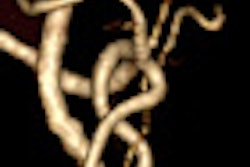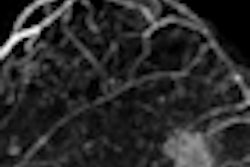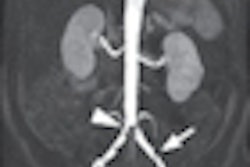VIENNA - Contrast agents with higher relaxivity are capable of providing greater tissue enhancement than conventional gadolinium-based contrast agents at equivalent doses, according to several studies presented Saturday at the European Congress of Radiology (ECR).
At the symposium hosted by Bracco Diagnostics, physicians cited clinical applications in which high-relaxivity MRI contrast media appear to be well-suited. Two examples are breast imaging and renal imaging.
On the use of contrast agents in breast MRI, Dr. Fiona Gilbert, from the Aberdeen Biomedical Imaging Centre at the University of Aberdeen in Scotland, said, "The question for the radiologist that is of most importance is: Is it actually going to improve our diagnostic performance and then improve the patient outcome?"
DETECT study
Gilbert cited the multicenter DETECT trial, which compared the efficacy of gadobenate dimeglumine (MultiHance, Bracco) in a head-to-head comparison with gadopentetate dimeglumine (Magnevist, Bayer HealthCare Pharmaceuticals) for breast MRI. The study, published online December 16, 2010, in Radiology, was sponsored by Bracco.
In the study, 162 women in Europe and China with a mean age of 52.8 years received at least one 1.5-tesla breast MRI scan using 3D spoiled gradient-echo sequences. Of those women, 151 subjects received both MultiHance and Magnevist in a randomized order with each identical exam between two and seven days apart.
Histopathological confirmation was available for all 144 malignant lesions, with 52 benign lesions confirmed either at 12-month follow-up or by mammogram or ultrasound.
All three blinded readers found MultiHance to be superior for malignant lesion detection compared with Magnevist and rated MultiHance higher for sensitivity, specificity, accuracy, positive predictive value, and negative predictive value. Both contrast agents were also found to have no safety issues.
Multiple modalities
The DETECT trial also compared the two contrast agents' performance among 135 women who received breast MRI, mammography, and/or ultrasound. Of those patients, 88 women received both mammography and ultrasound, 21 patients received only a mammogram, and 26 subjects were given an ultrasound.
A total of 122 malignant lesions were confirmed at histology in 109 patients who received an MRI and mammogram, while 123 malignant lesions were found in 114 patients through an MRI and ultrasound.
All three readers found superior cancer nodule detection with MRI enhanced by MultiHance (94% to 96%), compared with Magnevist-enhanced MRI (81% to 85%). In addition, the readers found better cancer nodule detection.
For Gilbert, the clinical relevance is how well the contrast agent will positively effect patient management and outcome.
"One of the things that I am particularly concerned about is the risk regarding BRCA1 and BRCA2 carriers and patients who are risk of being a breast cancer gene carrier," she said. Given that cancer can grow quickly in BRCA1 women, a breast MRI scan should be considered every six months, Gilbert noted.
BRCA 1 patients
"We know with BRCA 1 women that we need to detect these cancers smaller than 1 cm in size," she added. "So, anything that is going to increase sensitivity and specificity means I am going to use that in my screening. The fact that we have improved specificity with MultiHance means that it is likely we will be able to do an MRI and it is a better technique for preoperative staging."
Gadobenate dimeglumine has also shown its efficacy in renal imaging. "Clinically speaking, renal artery imaging is done for the detection of renal artery stenosis, which is the cause of uncontrollable hypertension in about 5% of the population," said Dr. Tim Leiner, from the Utrecht University Medical Center in Utrecht, the Netherlands. "We can use many imaging modalities to detect this [condition], but MRI complements the weaknesses of other modalities."
Previous conventional wisdom was that by dilating renal artery stenosis, blood pressure would decrease. However, more recent large-scale clinical trials have proved this hypothesis to be false and found that optimized medical treatment is more effective.
Sympathetic denervation
A recent study in the Lancet (December 2010, Vol. 376:9756, pp. 1903-1909) detailed a novel approach, called sympathetic denervation, in which a catheter is inserted into the renal artery to carefully ablate the stenosis in the renal artery wall. Early findings are that the technique prompts a significant reduction in blood pressure for as long as one year.
"So, the role of MRI is now switching from detecting renal artery stenosis to looking at the renal arteries to give interventionalists a preinterventional road map," Leiner noted.



















